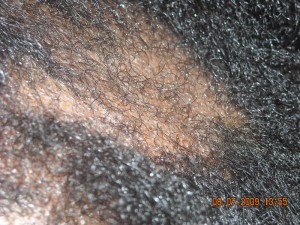Tinea Capitis
Candrice R. Heath, MD, Caroline N. Robinson, BS and Roopal V. Kundu, MD
 Tinea Capitis is a fungal infection that affects the scalp and hair. It is sometimes referred to as ringworm of the scalp. The signs and symptoms are variable, but most commonly include itchy, dry/flaky, bald patches on the scalp. Also in some cases, ringworm can result in severe inflammation and lead to permanent hair loss. Ringworm is very contagious and is frequently transmitted between young children. According to recent statistics, African-American and Hispanic children are most commonly affected.1,2
Tinea Capitis is a fungal infection that affects the scalp and hair. It is sometimes referred to as ringworm of the scalp. The signs and symptoms are variable, but most commonly include itchy, dry/flaky, bald patches on the scalp. Also in some cases, ringworm can result in severe inflammation and lead to permanent hair loss. Ringworm is very contagious and is frequently transmitted between young children. According to recent statistics, African-American and Hispanic children are most commonly affected.1,2
What is the cause of tinea capitis?
In the United States, tinea capitis is most often caused by a fungus (not a worm) called Trichophyton tonsurans.1 Depending on the causative fungus, tinea capitis can be acquired from other humans, plants or animals, though it is typically spread from human to human.1
A child can acquire ringworm by touching animals with asymptomatic infection, especially cats and dogs. The disease can also be spread through contact with objects such as: combs/brushes, clothing, linens and towels.
How do I know if I have tinea capitis?
Some signs of tinea capitis include hair loss (i.e., bald spots), dryness, flakiness, redness, pus, broken hairs (resembles black dots), fragile hair that is easily pulled out, open sores, tenderness. You may also have a swollen scalp and neck lymph nodes. As significant dandruff is uncommon in children, any flakiness of the scalp should be examined to rule out tinea capitis.1Your physician can take a sample of scale/ hair from your head and send it to be examined in the laboratory. Be aware that it may take several weeks for your sample to show signs of fungal growth.
What treatments are available for tinea capitis?
Unlike ringworm of the body, ringworm of the scalp must be treated with medications taken by mouth which may be prescribed for up to 8 weeks. Unfortunately, antifungal creams do not penetrate deep enough to adequately treat tinea capitis. The medication commonly prescribed to children is better absorbed with a fatty food (a spoonful of ice-cream).
If you are an adult, your doctor may check blood work before starting you on an antifungal oral medication to ensure that your liver is functioning appropriately. Although the most important treatment for tinea capitis is oral antifungal medications, an antifungal shampoo is typically prescribed (for the patient and their family members) to decrease the spread of the fungus.3
What actions should I take if I or any member of my family have been diagnosed with tinea capitis?
-Do not share hair brushes/combs, hats, caps or hooded clothing when the infection is active
-Any hair accessories, combs and brushes should be disinfected or thrown away to prevent reinfection or spread of disease.3
-Check all pets for patches of hair loss or dry skin. If noted to have any of these have them checked by a vet.
Download Spanish translation.
Descarga traducción en español.
References
1. Alvarez MS, Silverberg NB. Tinea Capitis. In: Kelly AP, Taylor SC, editors.
Dermatology for Skin of Color. New York: McGraw Hill Medical; 2009.
p.246-255.
2. Silverberg NB, Weinberg JM, DeLeo VA. Tinea capitis: Focus on AfricanAmerican
women. J Am Acad Dermatol 2002; 46S:120-4.
3. Sobera JO, Elewski BE. Fungal Diseases. In: Dermatology, 2nd ed.
Available at: www.expertconsult.com.

Cutis Journal
Read published peer-reviewed articles written your by Skin of Color Society members

Did You Know
Skin of color patients comprise the majority in California, New Mexico and Texas…and soon will be the majority in Arizona, Nevada, Georgia, New York and Florida.
By 2042, more than 50% of the US population will have skin of color.




